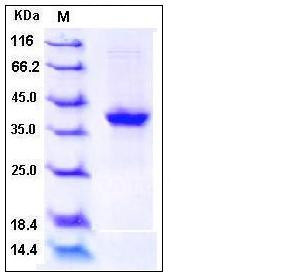Human S100A2 Protein (Fc Tag)
CAN19,S100L
- 100ug (NPP2475) Please inquiry
| Catalog Number | P10180-H01H |
|---|---|
| Organism Species | Human |
| Host | Human Cells |
| Synonyms | CAN19,S100L |
| Molecular Weight | The recombinant human Fc/S100A2 is a disulfide-linked homodimer. The reduced monomer consists of 334 amino acids and has a predicted molecular mass of 37.6 kDa. As a result of glycosylation, the apparent molecular mass of rh Fc/S100A2 monomer is approximately 40 kDa in SDS-PAGE under reducing conditions. |
| predicted N | Glu 20 |
| SDS-PAGE |  |
| Purity | > 95 % as determined by SDS-PAGE |
| Protein Construction | A DNA sequence encoding the human S100A2 (NP_005969.1) (Met 2-Pro98) was expressed with the fused Fc region of human IgG1 at the N-terminus. |
| Bio-activity | |
| Research Area | Cell Biology |Cell Cycle |Cell Differentiation |
| Formulation | Lyophilized from sterile 100mM Glycine, 10mM NaCl, 50mM Tris, pH 7.5 1. Normally 5 % - 8 % trehalose and mannitol are added as protectants before lyophilization. Specific concentrations are included in the hardcopy of COA. |
| Background | The calcium-binding Protein S100A2 is a member of the S100 family of proteins containing 2 EF-hand calcium-binding motifs. S100 family genes are located as a cluster on chromosome 1q21, and S100 proteins consisting of at least 20 members are involved in the regulation of a number of cellular processes such as cell-cycle progression and cell differentiation. S100A2 was first detected in lung and kidney, and is mainly expressed in a subset of tissues and cells such as breast epithelia and liver. The S100A2 protein is a homodimer that undergoes a conformational change upon binding of calcium, and the active form functions in regulating cell proliferation and differentiation, gene transcription, and p53-dependent growth arrest and apoptosis. Accordingly, this protein is regarded as a putative tumor suppressor, and thus chromosomal rearrangements and reduced expression of S100A2 gene have been implicated in certain carcinomas. |
| Reference |
